
Lake Malawi, also known as Lake Nyasa in Tanzania and Lago Niassa in Mozambique, is an African Great Lake and the southernmost lake in the East African Rift system, located between Malawi, Mozambique and Tanzania.
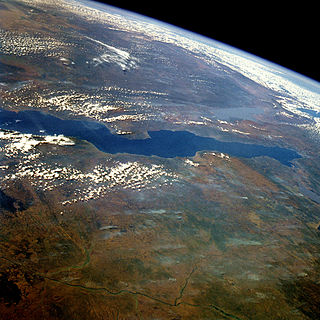
Lake Tanganyika is an African Great Lake. It is the second-oldest freshwater lake in the world, the second-largest by volume, and the second-deepest, in all cases after Lake Baikal in Siberia. It is the world's longest freshwater lake. The lake is shared among four countries—Tanzania, the Democratic Republic of the Congo (DRC), Burundi, and Zambia. With Tanzania (46%) and DRC (40%) possessing the majority of the lake. It drains into the Congo River system and ultimately into the Atlantic Ocean.

Mbuna is the common name for a large group of African cichlids from Lake Malawi, and are members of the haplochromine family. The name mbuna means "rockfish" in the language of the Tonga people of Malawi. As the name implies, most mbuna are cichlids that live among the piles of rocks and along the rocky shores of Lake Malawi, as opposed to the utaka, cichlids that live in the open water or on sandy shores or soft substrates. Some species of mbuna are highly sexually dimorphic, although many are not. Almost all of the cichlid species of Lake Malawi, including mbuna and non mbuna such as the utaka, are believed to have descended from one or a very few species that became isolated in the lake. With rising water levels, new habitats could be colonized and the many isolated rocky outcrops allowed new mbuna species to form. Their striking colors, intriguing behavioral characteristics, and relative hardiness make them very popular despite their unique demands for the home aquarist.

Bulinus is a genus of small tropical freshwater snails, aquatic gastropod mollusks in the family Bulinidae, the ramshorn snails and their allies.

Maylandia or Metriaclima is a genus of haplochromine cichlids endemic to Lake Malawi in East Africa. They belong to the mbuna (rock-dwelling) haplochromines.
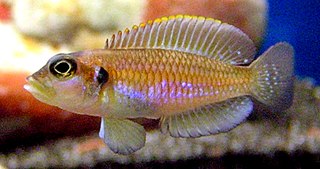
Lamprologus ocellatus is a species of shell dwelling cichlid endemic to Lake Tanganyika. It is a popular aquarium fish due to its small size, appearance, and intelligence.
A molluscivore is a carnivorous animal that specialises in feeding on molluscs such as gastropods, bivalves, brachiopods and cephalopods. Known molluscivores include numerous predatory molluscs,, arthropods such as crabs and firefly larvae, and, vertebrates such as fish, birds and mammals. Molluscivory is performed in a variety ways with some animals highly adapted to this method of feeding behaviour. A similar behaviour, durophagy, describes the feeding of animals that consume hard-shelled or exoskeleton bearing organisms, such as corals, shelled molluscs, or crabs.
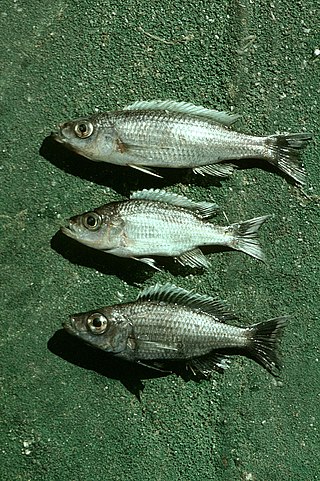
Diplotaxodon is a small genus of seven formally described, as well as a number of undescribed, deep-water species of cichlid fish endemic to Lake Malawi in east Africa. These fishes represent a remarkable adaptive radiation of offshore and deep-water adapted fish descended from ancestral shallow water forms. They include the dominant zooplankton-feeding fish of the offshore and deep-water regions of the lake, as well as a number of larger species that appear to feed on small pelagic fishes. Adult sizes range from 10 to 30 cm in total length, depending on species.

Trematocranus placodon is a species of cichlid fish endemic to Lake Malawi, Lake Malombe and the upper reaches of the Shire River in Africa. It is mainly a shallow-water species that prefers to occupy areas with patches of Vallisneria, but it can occur as deep as 31 m (102 ft). It can reach a total length of up to 25 cm (9.8 in).
Bulinus succinoides is a species of freshwater snail, a gastropod in the Planorbidae family. It is endemic to Lake Malawi.
Lanistes nyassanus is a species of large freshwater snail, an aquatic gastropod mollusk with a gill and an operculum in the family Ampullariidae, the apple snails. The shell of this species is unusual in that it has left-handed shell-coiling.
Melanoides nyassana is a species of freshwater snail with a gill and an operculum, an aquatic gastropod mollusk in the family Thiaridae.
Melanoides polymorpha is a species of freshwater snail with a gill and an operculum, an aquatic gastropod mollusk in the family Thiaridae.
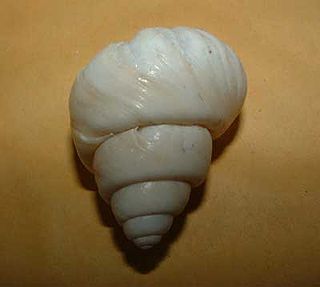
Neothauma is a genus of freshwater snail with a gill and an operculum, an aquatic gastropod mollusc in the subfamily Bellamyinae of the family Viviparidae.

Bulinus forskalii is a species of tropical freshwater snail with a sinistral shell, an aquatic gastropod mollusk in the family Bulinidae, the ramshorn snails and their allies.

Bulinus natalensis is a species of a tropical freshwater snail with a sinistral shell, an aquatic gastropod mollusk in the family Planorbidae, the ramshorn snails and their allies. Its geographical distribution is largely limited to Kwazulu-Natal in South Africa. This species occurs in standing, perennial freshwater habitat and has the ability to aestivate for up to six months during a drought.
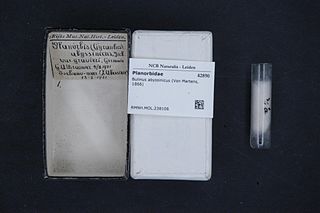
Bulinus abyssinicus is a species of tropical freshwater snail with a sinistral shell, an aquatic gastropod mollusk in the family Planorbidae, the ramshorn snails and their allies.

Bulinus jousseaumei is a species of tropical freshwater snail, an aquatic gastropod mollusk in the family Planorbidae, the ramshorn snails and their allies. Like other planorbids, the shell of the species is sinistral in coiling.
Bulinus nasutus is a species of tropical freshwater snail with a sinistral shell, an aquatic gastropod mollusk in the family Planorbidae, the ramshorn snails and their allies.

Angulyagra polyzonata is a species of a freshwater snail with a gill and an operculum, an aquatic gastropod mollusk in the family Viviparidae.














